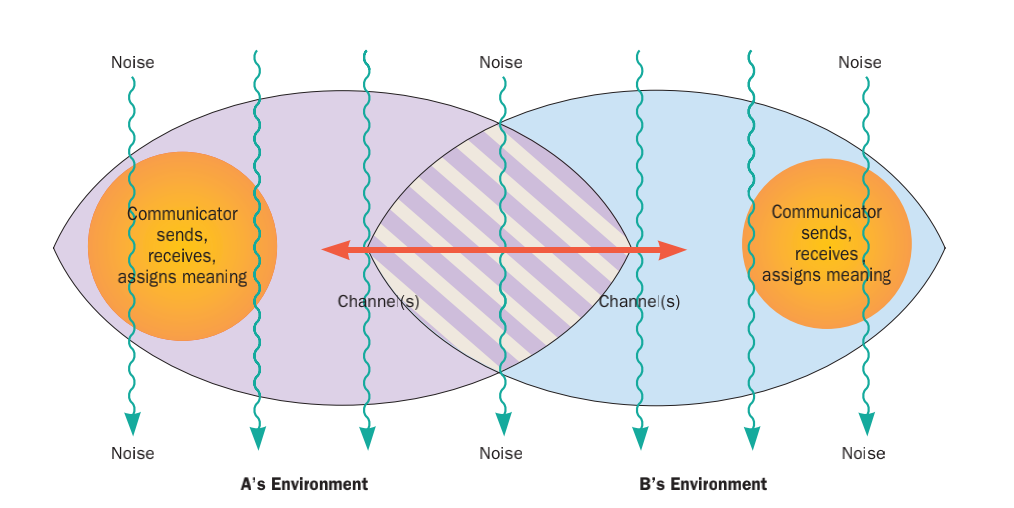|
Social Penetration Theory
The social penetration theory (SPT) proposes that as relationships develop, interpersonal communication moves from relatively shallow, non-intimate levels to deeper, more intimate ones. The theory was formulated by psychologists Irwin Altman of the University of Utah and Dalmas Taylor of the University of Delaware in 1973 to understand relationship development between individuals. Altman and Taylor noted that relationships "involve different levels of intimacy of exchange or degree of social penetration". SPT is known as an objective theory as opposed to an interpretive theory, meaning it is based on data drawn from actual experiments and not simply from conclusions based on individuals' specific experiences. SPT states that the relationship development occurs primarily through self-disclosure—when one intentionally reveals information such as personal motives, desires, feelings, thoughts, and experiences to others. This theory assumes that as people becomes closer with others, ... [...More Info...] [...Related Items...] OR: [Wikipedia] [Google] [Baidu] |
Interpersonal Communication
Interpersonal communication is an exchange of information between two or more people. It is also an area of research that seeks to understand how humans use verbal and nonverbal cues to accomplish a number of personal and relational goals. Interpersonal communication research addresses at least six categories of inquiry: 1) how humans adjust and adapt their verbal communication and nonverbal communication during face-to-face communication; 2) how messages are produced; 3) how uncertainty influences behavior and information-management strategies; 4) deceptive communication; 5) relational dialectics; and 6) social interactions that are mediated by technology. A large number of scholars have described their work as research into interpersonal communication. There is considerable variety in how this area of study is conceptually and operationally defined.Knapp & Daly, 2011) Researchers in interpersonal communication come from many different research paradigms and theoretical tradi ... [...More Info...] [...Related Items...] OR: [Wikipedia] [Google] [Baidu] |
Beliefs
A belief is an attitude that something is the case, or that some proposition is true. In epistemology, philosophers use the term "belief" to refer to attitudes about the world which can be either true or false. To believe something is to take it to be true; for instance, to believe that snow is white is comparable to accepting the truth of the proposition "snow is white". However, holding a belief does not require active introspection. For example, few carefully consider whether or not the sun will rise tomorrow, simply assuming that it will. Moreover, beliefs need not be ''occurrent'' (e.g. a person actively thinking "snow is white"), but can instead be ''dispositional'' (e.g. a person who if asked about the color of snow would assert "snow is white"). There are various different ways that contemporary philosophers have tried to describe beliefs, including as representations of ways that the world could be (Jerry Fodor), as dispositions to act as if certain things are true (Rod ... [...More Info...] [...Related Items...] OR: [Wikipedia] [Google] [Baidu] |
Parasocial Interaction
Parasocial interaction (PSI) refers to a kind of psychological relationship experienced by an audience in their mediated encounters with performers in the mass media, particularly on television and on online platforms. Viewers or listeners come to consider media personalities as friends, despite having no or limited interactions with them. PSI is described as an illusionary experience, such that media audiences interact with personas (e.g., talk show hosts, celebrities, fictional characters, social media influencers) as if they are engaged in a reciprocal relationship with them. The term was coined by Donald Horton and Richard Wohl in 1956. A parasocial interaction, an exposure that garners interest in a persona, becomes a parasocial relationship after repeated exposure to the media persona causes the media user to develop illusions of intimacy, friendship, and identification. Positive information learned about the media persona results in increased attraction, and the relati ... [...More Info...] [...Related Items...] OR: [Wikipedia] [Google] [Baidu] |
Reality Television
Reality television is a genre of television programming that documents purportedly unscripted real-life situations, often starring unfamiliar people rather than professional actors. Reality television emerged as a distinct genre in the early 1990s with shows such as ''The Real World'', then achieved prominence in the early 2000s with the success of the series '' Survivor'', '' Idols'', and '' Big Brother'', all of which became global franchises. Reality television shows tend to be interspersed with "confessionals", short interview segments in which cast members reflect on or provide context for the events being depicted on-screen; this is most commonly seen in American reality television. Competition-based reality shows typically feature gradual elimination of participants, either by a panel of judges, by the viewership of the show, or by the contestants themselves. Documentaries, television news, sports television, talk shows, and traditional game shows are generally not clas ... [...More Info...] [...Related Items...] OR: [Wikipedia] [Google] [Baidu] |
Psychotherapy
Psychotherapy (also psychological therapy, talk therapy, or talking therapy) is the use of psychological methods, particularly when based on regular personal interaction, to help a person change behavior, increase happiness, and overcome problems. Psychotherapy aims to improve an individual's well-being and mental health, to resolve or mitigate troublesome behaviors, beliefs, compulsions, thoughts, or emotions, and to improve relationships and social skills. Numerous types of psychotherapy have been designed either for individual adults, families, or children and adolescents. Certain types of psychotherapy are considered evidence-based for treating some diagnosed mental disorders; other types have been criticized as pseudoscience. There are hundreds of psychotherapy techniques, some being minor variations; others are based on very different conceptions of psychology. Most involve one-to-one sessions, between the client and therapist, but some are conducted with groups, incl ... [...More Info...] [...Related Items...] OR: [Wikipedia] [Google] [Baidu] |
LGBT
' is an initialism that stands for lesbian, gay, bisexual, and transgender. In use since the 1990s, the initialism, as well as some of its common variants, functions as an umbrella term for sexuality and gender identity. The LGBT term is an adaptation of the initialism ', which began to replace the term ''gay'' (or ''gay and lesbian'') in reference to the broader LGBT community beginning in the mid-to-late 1980s. When not inclusive of transgender people, the shorter term LGB is still used instead of LGBT. It may refer to anyone who is non-heterosexual or non-cisgender, instead of exclusively to people who are lesbian, gay, bisexual, or transgender. To recognize this inclusion, a popular variant, ', adds the letter ''Q'' for those who identify as queer or are questioning their sexual or gender identity. The initialisms ''LGBT'' or ''GLBT'' are not agreed to by everyone that they are supposed to include. History of the term The first widely used term, '' homosexual'', ... [...More Info...] [...Related Items...] OR: [Wikipedia] [Google] [Baidu] |
Sexual Orientation
Sexual orientation is an enduring pattern of romantic or sexual attraction (or a combination of these) to persons of the opposite sex or gender, the same sex or gender, or to both sexes or more than one gender. These attractions are generally subsumed under heterosexuality, homosexuality, and bisexuality, while asexuality (the lack of sexual attraction to others) is sometimes identified as the fourth category. These categories are aspects of the more nuanced nature of sexual identity and terminology. For example, people may use other labels, such as ''pansexual'' or '' polysexual'', or none at all. According to the American Psychological Association, sexual orientation "also refers to a person's sense of identity based on those attractions, related behaviors, and membership in a community of others who share those attractions". ''Androphilia'' and ''gynephilia'' are terms used in behavioral science to describe sexual orientation as an alternative to a gender binary conce ... [...More Info...] [...Related Items...] OR: [Wikipedia] [Google] [Baidu] |
Lesbian
A lesbian is a Homosexuality, homosexual woman.Zimmerman, p. 453. The word is also used for women in relation to their sexual identity or sexual behavior, regardless of sexual orientation, or as an adjective to characterize or associate nouns with female homosexuality or same-sex attraction. The concept of "lesbian" to differentiate women with a shared sexual orientation evolved in the 20th century. Throughout history, women have not had the same freedom or independence as men to pursue homosexual relationships, but neither have they met the same harsh punishment as homosexual men in some societies. Instead, lesbian relationships have often been regarded as harmless, unless a participant attempts to assert privileges traditionally enjoyed by men. As a result, little in history was documented to give an accurate description of how female homosexuality was expressed. When early sexologists in the late 19th century began to categorize and describe homosexual behavior, hampere ... [...More Info...] [...Related Items...] OR: [Wikipedia] [Google] [Baidu] |
Social Anxiety Disorder
Social anxiety disorder (SAD), also known as social phobia, is an anxiety disorder characterized by sentiments of fear and anxiety in social situations, causing considerable distress and impaired ability to function in at least some aspects of daily life.National Institute for Health and Clinical Excellence: GuidanceSocial Anxiety Disorder: Recognition, Assessment, and Treatment Leicester (UK): British Psychological Society; 2013. These fears can be triggered by perceived or actual scrutiny from others. Individuals with social anxiety disorder fear negative evaluations from other people. Physical symptoms often include excessive blushing, excess sweating, trembling, palpitations, and nausea. Stammering may be present, along with rapid speech. Panic attacks can also occur under intense fear and discomfort. Some affected individuals may use alcohol or other drugs to reduce fears and inhibitions at social events. It is common for those with social phobia to self-medicate in ... [...More Info...] [...Related Items...] OR: [Wikipedia] [Google] [Baidu] |
Archives Of Sexual Behavior
The ''Archives of Sexual Behavior'' is a peer-reviewed academic journal in sexology. It is the official publication of the International Academy of Sex Research. History The journal was established in 1971 by Richard Green, who served as its editor-in-chief until 2001. He was succeeded by Kenneth J. Zucker. It is published by Springer Science+Business Media and has become a leading journal in its field. Associated with its editorial board and the International Academy of Sex Research are many of the world's leading figures in gender and sexuality research, including Richard Green, Kenneth Zucker, Milton Diamond, J. Michael Bailey, and Carol Martin. Article categories The types of articles published in the journal include: * empirical research (both quantitative and qualitative) * theoretical reviews and essays * clinical case reports * letters to the editor * book reviews Abstracting and indexing ''Archives of Sexual Behavior'' is abstracted and indexed in Biological Abst ... [...More Info...] [...Related Items...] OR: [Wikipedia] [Google] [Baidu] |
Cathartic
In medicine, a cathartic is a substance that ''accelerates'' defecation. This is similar to a laxative, which is a substance that ''eases'' defecation, usually by softening feces. It is possible for a substance to be both a laxative and a cathartic. However, agents such as psyllium seed husks increase the bulk of the feces. Cathartics such as sorbitol, magnesium citrate, magnesium sulfate, or sodium sulfate were previously used as a form of gastrointestinal decontamination following poisoning via ingestion. They are no longer routinely recommended for poisonings. High-dose cathartics may be an effective means of ridding the lower gastrointestinal tract of toxins; however, they carry a risk of electrolyte imbalances and dehydration. Catharsis can be an effect of pesticide poisonings, such as with elemental sulfur Sulfur (or sulphur in British English) is a chemical element with the symbol S and atomic number 16. It is abundant, multivalent and nonmetallic. Under normal ... [...More Info...] [...Related Items...] OR: [Wikipedia] [Google] [Baidu] |
Social Media
Social media are interactive media technologies that facilitate the creation and sharing of information, ideas, interests, and other forms of expression through virtual communities and networks. While challenges to the definition of ''social media'' arise due to the variety of stand-alone and built-in social media services currently available, there are some common features: # Social media are interactive Web 2.0 Internet-based applications. # User-generated content—such as text posts or comments, digital photos or videos, and data generated through all online interactions—is the lifeblood of social media. # Users create service-specific profiles for the website or app that are designed and maintained by the social media organization. # Social media helps the development of online social networks by connecting a user's profile with those of other individuals or groups. The term ''social'' in regard to media suggests that platforms are user-centric and enable communal ac ... [...More Info...] [...Related Items...] OR: [Wikipedia] [Google] [Baidu] |






